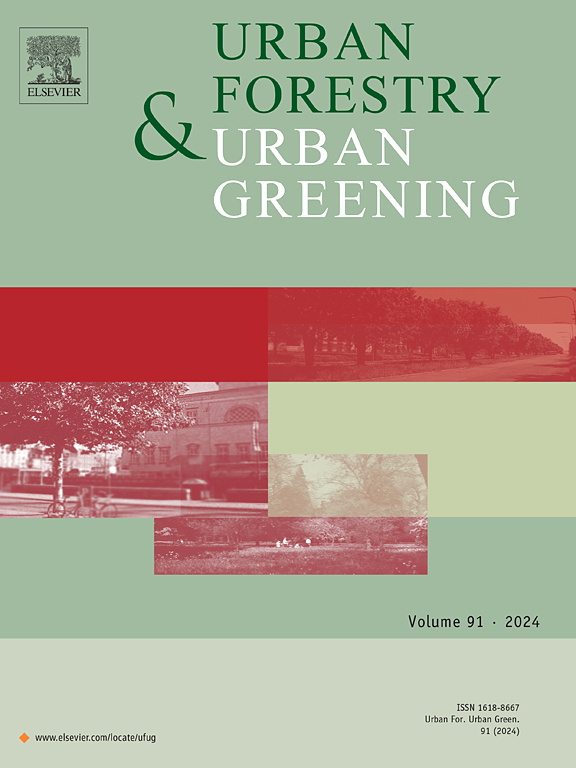绿色连接:北京儿童与自然的体验和感知心理健康
IF 6
2区 环境科学与生态学
Q1 ENVIRONMENTAL STUDIES
引用次数: 0
摘要
如今,在城市中长大的孩子越来越远离自然世界,与此同时,儿童心理问题也在上升。虽然研究人员已经探索了接触自然的可能性,以减轻这些问题,但大多数研究都集中在成年人身上,并优先考虑接触自然的定量测量。本研究的重点是儿童与自然互动的质量和相关的感知心理恢复性。该研究涉及来自中国北京市中心四个区的81名8-12岁的儿童及其父母。半结构化访谈用于调查儿童在三个时间框架内与自然的体验——上学期间、放学后和周末。他们的感知心理恢复性使用儿童感知恢复性成分量表的修订版进行评估。结果表明,孩子们更频繁地参加体育锻炼,而不是自然活动。有组织的自然体验在上学时间占主导地位,而无组织的活动在放学后和周末更常见。儿童与自然互动的九种类型也被确定,与建设性、创造性、幻想和温室体验相比,视觉体验是最常被提及的,周末为儿童提供了最多样化的自然体验。从上学时间到放学时间,他们感知到的心理恢复能力逐渐增强,并在周末达到顶峰。该研究探讨了环境和与自然接触的质量(强调非结构化体验)的影响,以及定量因素,如在自然中花费的时间和对自然和自然世界元素的可及性。研究结果对特定时空背景下儿童自然体验与感知心理健康之间的关系提供了深入的理解,并为多方利益相关者提供了策略,以促进儿童更融入自然和支持性的生活环境。本文章由计算机程序翻译,如有差异,请以英文原文为准。
Green connections: Children’s experiences with nature and perceived psychological well-being in Beijing, China
Children growing up in cities today are becoming increasingly disconnected from the natural world, which coincides with a rise in psychological problems among children. While researchers have explored the potential of exposure to nature to mitigate these issues, most studies have focused on adults and prioritized quantitative measures of exposure to nature. This study focused on the quality of children’s interactions with nature and associated perceived psychological restorativeness. It involved 81 children aged 8–12 years from four districts in central Beijing, China, and their parents. Semi-structured interviews were used to investigate children’s experiences with nature across three timeframes – during and after school, and on weekends. Their perceived psychological restorativeness was assessed using a revised version of the Perceived Restorative Component Scale for Children. The results show that the children were more frequently engaged in physical exercises than nature-based activities. Structured experiences with nature predominated during school hours, while unstructured activities were more common after school and on weekends. Nine types of children’s interactions with nature were also identified, with visual experiences being the most frequently mentioned, compared to constructive, creative, fantasy, and conservatory experiences, with weekends offering children the most diverse experiences of nature. Their perceived psychological restorativeness increased progressively from school hours to after school and peaked on weekends. The study explored the impacts of context and quality of contacts with nature (emphasizing unstructured experiences), as well as quantitative factors such as time spent in and accessibility to nature and elements of the natural world. The results provide an in-depth understanding of the relationship between children’s experiences of nature and perceived psychological well-being within specific time-space contexts, suggesting strategies for multi-stakeholders to foster a more nature-integrated and supportive living environment for children.
求助全文
通过发布文献求助,成功后即可免费获取论文全文。
去求助
来源期刊

Urban Forestry & Urban Greening
FORESTRY-
CiteScore
11.70
自引率
12.50%
发文量
289
审稿时长
70 days
期刊介绍:
Urban Forestry and Urban Greening is a refereed, international journal aimed at presenting high-quality research with urban and peri-urban woody and non-woody vegetation and its use, planning, design, establishment and management as its main topics. Urban Forestry and Urban Greening concentrates on all tree-dominated (as joint together in the urban forest) as well as other green resources in and around urban areas, such as woodlands, public and private urban parks and gardens, urban nature areas, street tree and square plantations, botanical gardens and cemeteries.
The journal welcomes basic and applied research papers, as well as review papers and short communications. Contributions should focus on one or more of the following aspects:
-Form and functions of urban forests and other vegetation, including aspects of urban ecology.
-Policy-making, planning and design related to urban forests and other vegetation.
-Selection and establishment of tree resources and other vegetation for urban environments.
-Management of urban forests and other vegetation.
Original contributions of a high academic standard are invited from a wide range of disciplines and fields, including forestry, biology, horticulture, arboriculture, landscape ecology, pathology, soil science, hydrology, landscape architecture, landscape planning, urban planning and design, economics, sociology, environmental psychology, public health, and education.
 求助内容:
求助内容: 应助结果提醒方式:
应助结果提醒方式:


